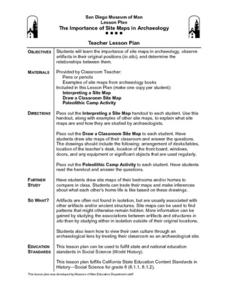Curated OER
Famous Person: Yushiko Uchida
Third, fourth, and fifth graders read the book The Bracelet by Yushiko Uchida and examine the events of Uchida's life. They participate in a guided discussion of Japanese culture, perform a reader's theater, listen to a guest speaker,...
Curated OER
The 1950s:
Teens will get a kick out of this presentation, which provides a glimpse of the consumerism and rising pop culture of 1950's America. They will especially appreciate the discussion of "Teen culture" including the music of Elvis, the...
Curated OER
Shoes and the Backyard Landscape
Your shoes get a lot of mileage in familiar places. Represent the places you have traveled the most with an art project based on a print of Indian People Wear Shoes and Socks by Juane Quick-to-See Smith. Kids trace their shoes and draw...
Curated OER
Artifacts 1: What Can We Learn From Artifacts?
Sixth graders are introduced to artifacts and explore an online archaeological site to connect clues about how people once lived. In this deductive reasoning lesson, 6th graders participate in the stratigraphy game on Kids Dig Reed.com...
Curated OER
Splat! Boom! Pow! the Influence of Cartoons in Contemporary Art
Students relate abstract expressionism and cultural influences on 1960's art. They use images appropriated from comic books to create a painting in the abstract expressionist style by changing the scale of the comic and reducing content...
Curated OER
Youth and Class, Gender and Ethnicity
For this Youth and Class worksheet, students provide examples of three different subcultures, provide explanations for concepts, and answer a variety of questions about subcultures.
Curated OER
My Home, Your Home
Students evaluate different kinds of homes and living situations. They focus on a Korean grandfather's home and analyze the effects of culture upon home lives and structures. They draw their own homes as a final project.
Curated OER
Artful Installations: 3D Constructions
Students create a larger than life recreation of a famous painting after becoming familiar with a famous artist's work through reading and exploration. They view and discuss slides from a variety of major art museums. They analyze and...
Curated OER
Families Around the World
Students discover the similarities and differences in families from around the world. In this multicultural lesson, students create their own family album and label each family member. There are suggested activities such as investigating...
Curated OER
Area and Perimeter Floor Plan
Using Google SketchUp, learners draw a model of their bedroom. They begin by measuring the dimensions of their bedroom, inputting this information into the software program, and calculating perimeter and area. This is an interesting and...
Curated OER
Odd One Out
In this categorizing activity, learners read 10 questions regarding a wide range of topics and identify the answers in each that are not correct.
Curated OER
FAMOUS PAINTING
Students provide a brief history of Van Gogh and of the artists working at the same time. They use images of the furniture copied from the painting to review vocabulary items, color, size, etc. They draw and color a rendition of their...
University of Kansas
Exponential and Logarithm Problems
This worksheet manages to provide both fun and serious work solving exponential and logarithmic application problems in engaging story lines and real-life situations. A strong emphasis on science applications and numbers pulled straight...
Poetry4kids
How to Write a Tanka Poem
Take your haikus to the next level with tanka poems, another form of Japanese poetry that regulates the length and rhythm of each line by syllables. Young writers read the explanation, examples, and tips for tanka poems before writing...
Curated OER
Invetories Slave owner or not?
Primary source analysis is a great way to bring history to life. Learners examine a series of personal inventories taken from Southern white males who died during the Civil War era. They analyze the documents to determine the social and...
Curated OER
Things Fall Apart: Question Answer Response Theory
Passages from Chinua Achebe's Things Fall Apart provide the text for a QAR: Question Answer Response comprehension activity. Readers respond to right there, think and search, on your own, and author and you questions.
Curated OER
As the Kids Come and Go: Mapping a Classroom
Map the classroom with your kids to help them understand how maps work and how to read them. The lesson starts off with a story about animals living and moving around the globe, and then kids create maps of their classroom to show how...
Curated OER
Nonfiction Text: Comprehension Practice
A New York Times article about a 15-year-old style maven who in 2011 launched the fashion magazine "Rookie," based on her blog, makes high-interest nonfiction reading for secondary learners. This page asks 9 comprehension questions...
Curated OER
Vision Disorder
Pupils design a morning routine for a 60 year old female senior with vision disorder. In this biology lesson, students collaborate with their team to come up with possible solutions. They present at least two ideas of their design to the...
Curated OER
The Importance of Site Maps in Archaeology
Students consider the importance of site maps in archeology. They interpret site maps, draw site maps of their classroom and home and then participate in simulated Paleolithic archeological camp activity.
Curated OER
Revealing Process
Students investigate the method of collage in art in part of a study of Dada and Surrealist art. In this art analysis lesson, students explore how artists incorporated materials from everyday life into their art works. Students complete...
Curated OER
Brian's family
For this comprehension worksheet, students read a story about a family and answer short answer questions, fill in the blanks to sentences, complete dialogues, and more. Students complete 9 activities.
Curated OER
WWW, Part 3: The Future
Students explore a variety of Internet sites provided to provide tools to speed up their net experiences. The lesson plan was originally written for librarians with little or no net experiences.
























